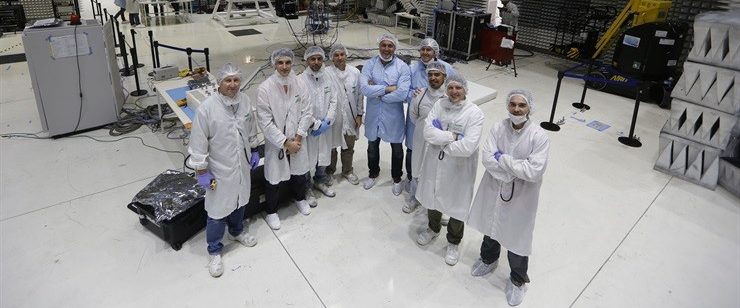UTNBA Graduate participates in the development of the SAOCOM satellite
With the information obtained from the satellites it will be possible to generate precise and high resolution maps of soil moisture.

Eng. Mariano Romero, a graduate of UTNBA, is part of the INVAP work team that developed technology for the SAOCOM 1 A satellite, to be launched next September by the National Space Activities Commission (CONAE).
“I have been working at INVAP for 7 years. I started in the radar area, and a year later I switched to the satellite area. For six years I have been working for the SAOCOM. I started putting the first screw in the Integration of its structural model and since then I have not left it,” Romero explained.
Fernando Hisas, Project Manager of CONAE, explained that preliminary tests are being carried out for the launch of the first satellite of the SAOCOM mission, which “consists of two satellites: 1 A, which is being launched this year, and 1 B, which will be launched within a year.”
With the information obtained from the satellites it will be possible to generate precise and high resolution maps of soil moisture.
“It will generate a primary product -it is basically designed for our humid pampa region-, from which many applications can be made, such as evaluating the right time for sowing and harvesting, among others,” Hisas said.
“It is also related -he continued- with plant health. There is an application, for example, to detect a bug called “fusarium”, which appears in wheat and causes big damage. This would allow us to anticipate the appearance of that agent.”
Another application of the satellite is the prevention of fires, and the forecast of floods, “by measuring the humidity of the soil, ground water saturations can be detected which, in case of a rain forecast, warn about a possible flood. The same happens with very dry soils which, in case of a drought forecast, increase the risk of fire,” he explained.
Once the flood or fire has occurred, the information gathered by the radar allows us to detect the affected areas and follow up the evolution of the phenomenon because it can capture data from even below the surface or through the trees.
“It has other applications such as detection of ships at sea, agriculture monitoring, and crop identification,” Hisas said.
The lifetime of a satellite such as SAOCOM is between 5 and 7 years on average.
The Project Manager of CONAE explained that the development of the SAOCOM satellites began to be planned more than 20 years ago, when the Space Plan began to be developed: “there was a first stage in which we learned to design and build a radar, it had never been done in the country, let alone to fly in space. That took time,” he said.
CONAE and INVAP had no experience in radar development, which represented a challenge that required significant training. “We also had to learn to define exactly what characteristics we wanted these radars to have. The measurement of soil moisture is something that does not exist with the radar so far. Then we had to solve in some way how to put that radar in space and finally, to build the qualification and flight models,” Hisas recalled.
Through a public bidding, it was defined that the launch will be conducted by the North American company SkyMed, which is currently carrying out re-mission flights of the space mission.
“The launch will take place at a company facility on the west coast of the United States, between Los Angeles and San Francisco, and it is scheduled for the month of September, although there is still no definite date,” he explained.
A Graduate in SAOCOM
Mariano Romero graduated as an Industrial Engineer in UTNBA and since he moved to Bariloche, he has taught at UTNBA’s premises in Bariloche and he has been also working for INVAP, CONAE’s main contractor for the SAOCOM satellite.
“I never thought I would be working on such a project. I did it when I was already working in Bariloche and I contacted INVAP,” he recalled.
“UTNBA -he continued- gave me the possibility of gaining work experience in parallel to academic training. Working while studying does not affect academic quality. This is key because when you graduate, you graduate with experience that academic training alone cannot give you.”
The UTNBA graduate explained that the developments in which INVAP is working for the satellite are in the trial phase: “the main challenge is to put the satellite in space, and that challenge is led by CONAE. We are the ones who materialize the satellite,” he said.
For Romero, “the fact of being able to master a technology like the satellite’s allows us to be among the 10 or 15 countries that are working on it. That positions us worldwide. And it is beneficial from the economic, the strategic, the geopolitical point of view, etc.”



